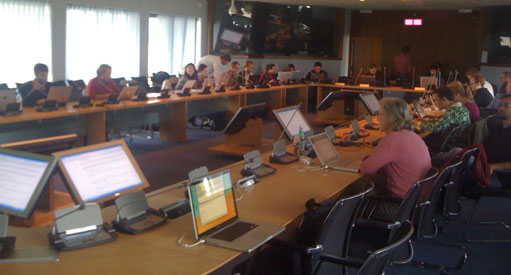
ATLAS e-News
23 February 2011
Analysis tutorials
16 November 2009

A session from the October tutorial
With data so close we can almost smell it, now is the time to make sure we’re equipped to analyse it. “People are going to have to realise the days of working at their desktop, processing files on their hard drive, are over,” says James Catmore, organiser of the Offline Software Tutorials.
The quantity of data needed for finding new physics is so large that it will be impossible to do ATLAS physics without the Grid. “Really, people who aren’t able to use the Grid on day one are going to be almost cut out from being able to work.”
To ensure that everyone can participate in early physics analysis, the Regular Computing Tutorial Twiki has been online since July 2008, available from the main ATLAS software and computing page. Regular Offline Software Tutorials give users access to the experts responsible for writing the software for finding new physics in ATLAS data.
The most recent of these ran from 21 to 23 October. James stresses that these tutorials are for everyone, “from Master’s thesis students all the way up to project leaders.” Heads of groups come to sessions alongside their own PhD students, and everyone takes something new away.
The tutorials are hands-on and somewhat self-guided. The three days of sessions opened with a brief introductory lecture before jumping into activities. “The idea is we start from the very most basic principles, and then immediately, within the first hour, they’re on their laptops,” says James.
Participants are expected to come Grid-certified, and important for newcomers, fully registered in ATLAS. During the tutorial, participants have expert help in setting up the ATLAS software and running their first, basic “hello world”-type jobs. Sessions go over what physics objects can be identified in the data and delve into finding them, making plots from data using the analysis software. Finally the participants are shown how to do all of this on the Grid.
New for the October sessions, the trigger group has provided a tutorial, and a more realistic sample, provided by the top group, was available. Richard Hawkings, one of the top group conveners, has mixed a number of Monte Carlo samples into one dataset and added luminosity and data quality information. This allowed the luminosity and data quality tools to be demonstrated in the tutorial. “The exercises were as realistic as it’s possible to get before we have collisions,” says James.
The maximum number of participants varies according to where the tutorials are held, but James likes to keep registration to 60 participants or less. With only one or two tutors at a time, it’s difficult to pay adequate attention to individuals when the group is much larger than that. “Obviously not all the people come to all the sessions,” he adds, as some have conflicting meetings or already understand the aspect of the software to be covered.
Also, due to the broad range of proficiencies among participants, James says: “We find it’s best to just let people work through the exercises on their own computers in their own time.” For this reason, the attendees were introduced to a topic and then shown what section to work through in the Regular Computing Tutorial Twiki.
“Though the documentation is sufficient to work through the tutorials by oneself, it is much more efficient to attend the tutorial sessions and get immediate help when glitches happen,” says Traudl Kozanecki.
“The atmosphere was nice, the teachers very clever and friendly, the room a bit uncomfortable for the first day, but overall a very nice and positive experience,” says Daniela Rebuzzi, with a wealth of knowledge in muon simulation and the Higgs-to-four-lepton decay channel. “It is amazing to see how the ATLAS software has evolved since when I started working on it!”
The knowledge of participants like Daniela and Traudl brings an interesting dynamic to the sessions as often, the expert tutors will gain a new perspective on the software they write from interactions with experienced physicists, who have done extensive work in areas of ATLAS or on other projects, such as CDF or BaBar.
For ATLAS newcomer Lucie de Nooij, working on her PhD, untangling the acronyms and learning about the variety of analysis tools available was most helpful. “Now I can choose what I think is most useful for the thing I need to do,” she says.
One weakness in the program, mentioned by both Lucie and Daniela, was that the time to work through the tutorial with access to the experts was a bit shorter than they would have liked. But with the next tutorial extended to a fourth day in December, running from the 7th to the 10th, perhaps this will be remedied.
And Traudl believes the tutorial has saved her much effort compared to trying to master the software alone: “I strongly recommend taking the time to attend the sessions; the few days spent save a lot of time needed otherwise.”

Katie McAlpineATLAS e-News |